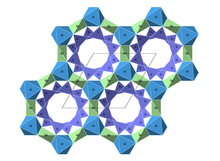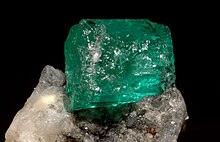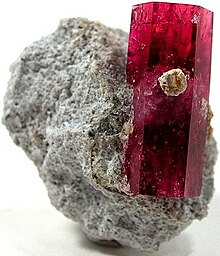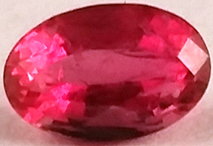Beryl
| Beryl | ||
|---|---|---|
Specific gravity 2.63–2.92 | | |
| Optical properties | Uniaxial (−) | |
| Refractive index | nω = 1.564–1.595 nε = 1.568–1.602 | |
| Birefringence | δ = 0.0040–0.0070 | |
| Pleochroism | Weak to distinct | |
| Ultraviolet fluorescence | None (some fracture-filling materials used to improve emerald's clarity do fluoresce, but the stone itself does not). Morganite has weak violet fluorescence. | |
| References | [2][3][4][5]: 112 | |
Beryl (

Etymology
The word beryl –
When the first eyeglasses were constructed in 13th-century Italy, the lenses were made of beryl (or of rock crystal) as glass could not be made clear enough. Consequently, glasses were named Brillen in German[10] (bril in Dutch and briller in Danish).
Deposits
Beryl is a common mineral, and it is widely distributed in nature. It is found most commonly in
Crystal habit and structure

Beryl belongs to the
Human health impact
Beryl is a beryllium compound that is a known carcinogen with acute toxic effects leading to pneumonitis when inhaled.[15] Care must thus be used when mining, handling, and refining these gems.[16]
Varieties
Aquamarine and maxixe

Aquamarine (from

The pale blue color of aquamarine is attributed to Fe2+. Fe3+ ions produce golden-yellow color, and when both Fe2+ and Fe3+ are present, the color is a darker blue as in maxixe.[22][23] Decoloration of maxixe by light or heat thus may be due to the charge transfer between Fe3+ and Fe2+.[24]
In the United States, aquamarines can be found at the summit of
Emerald

Emerald is green beryl, colored by around 2% chromium and sometimes vanadium.[32][33] Most emeralds are highly included, so their brittleness (resistance to breakage) is classified as generally poor.[34]
The modern English word "emerald" comes via Middle English emeraude, imported from modern French via Old French ésmeraude and Medieval Latin esmaraldus, from Latin smaragdus, from Greek σμάραγδος smaragdos meaning 'green gem'.[b]

Emeralds in antiquity were mined by the
Emerald is a rare and valuable gemstone and, as such, it has provided the incentive for developing synthetic emeralds. Both hydrothermal[37] and flux-growth synthetics have been produced. The first commercially successful emerald synthesis process was that of Carroll Chatham.[38] The other large producer of flux emeralds was Pierre Gilson Sr., which has been on the market since 1964. Gilson's emeralds are usually grown on natural colorless beryl seeds which become coated on both sides. Growth occurs at the rate of 1 millimetre (0.039 in) per month, a typical seven-month growth run producing emerald crystals of 7 mm of thickness.[39] The green color of emeralds is widely attributed to presence of Cr3+ ions.[40][22][23] Intensely green beryls from Brazil, Zimbabwe and elsewhere in which the color is attributed to vanadium have also been sold and certified as emeralds.[41][42][43]
Golden beryl and heliodor

Golden beryl can range in colors from pale yellow to a brilliant gold. Unlike emerald, golden beryl generally has very few flaws. The term "golden beryl" is sometimes synonymous with heliodor (from Greek hēlios – ἥλιος "sun" + dōron – δῶρον "gift") but golden beryl refers to pure yellow or golden yellow shades, while heliodor refers to the greenish-yellow shades. The golden yellow color is attributed to Fe3+ ions.[32][40] Both golden beryl and heliodor are used as gems. Probably the largest cut golden beryl is the flawless 2,054-carat (410.8 g) stone on display in the Hall of Gems, Washington, D.C., United States.[44]
Goshenite


Colorless beryl is called goshenite. The name originates from Goshen, Massachusetts, where it was originally discovered. In the past, goshenite was used for manufacturing eyeglasses and lenses owing to its transparency. Nowadays, it is most commonly used for gemstone purposes.[45][46]
The gem value of goshenite is relatively low. However, goshenite can be colored yellow, green, pink, blue and in intermediate colors by irradiating it with high-energy particles. The resulting color depends on the content of Ca, Sc, Ti, V, Fe, and Co impurities.[40]
Morganite


Morganite, also known as "pink beryl", "rose beryl", "pink emerald" (which is not a legal term according to the new Federal Trade Commission Guidelines and Regulations), and "cesian (or caesian) beryl", is a rare light pink to rose-colored gem-quality variety of beryl. Orange/yellow varieties of morganite can also be found, and color banding is common. It can be routinely heat treated to remove patches of yellow and is occasionally treated by irradiation to improve its color. The pink color of morganite is attributed to Mn2+ ions.[32]
Red beryl

Red variety of beryl (the "bixbite") was first described in 1904 for an occurrence, its type locality, at Maynard's Claim (Pismire Knolls), Thomas Range, Juab County, Utah.[47][48] The dark red color is attributed to Mn3+ ions.[32] Old synonym "bixbite" is deprecated from the CIBJO because of the possibility of confusion with the mineral bixbyite (both named after mineralogist Maynard Bixby).[49] Red "bixbite" beryl formerly was marketed as "red" or "scarlet emerald", but these terms involving "Emerald" terminology are now prohibited in the US.[50]

Red beryl is very rare and has only been reported from a handful of North American locations: Wah Wah Mountains, Beaver County, Utah; Paramount Canyon, Round Mountain, Juab County, Utah; and Sierra County, New Mexico, although this locality does not often produce gem-grade stones.[47] The bulk of gem-grade red beryl comes from the Ruby-Violet Claim in the Wah Wah Mts. of midwestern Utah, discovered in 1958 by Lamar Hodges, of Fillmore, Utah, while he was prospecting for uranium.[51] Red beryl has been known to be confused with pezzottaite, a caesium analog of beryl, found in Madagascar and, more recently, Afghanistan; cut gems of the two varieties can be distinguished by their difference in refractive index, and the rough crystals easily by their differing crystal systems (pezzottaite trigonal, red beryl hexagonal). Synthetic red beryl is also produced.[52] Like emerald and unlike most other varieties of beryl, the red ones are usually highly included.
While gem beryls are ordinarily found in pegmatites and certain metamorphic stones, red beryl occurs in topaz-bearing
Footnotes
- ^
Compare veruḷiya and veḷuriya to the pseudo-"cat's eye" (gem), generic "jewel", or "lapis lazuli" (gem). The folk etymology explains the gem name as meaning "[brought] from [the city of] Vidūra".[8]
- ^
The Hoshen pectoral pendant of the Kohen HaGadol. The word bareket is also used to mean "lightning flash". It may be related to Akkadian baraqtu, which means "emerald". In turn the semetic language words are possibly related to the Sanskrit word मरकत marakata, meaning "green".[35][unreliable source?]
See also
- Chrysoberyl – Mineral or gemstone of beryllium aluminate
- List of minerals – List of minerals with Wikipedia articles
- List of emeralds by size
References
- S2CID 235729616.
- ^ a b "Beryl". mindat.org. Archived from the original on 26 October 2007.
- ^ "Beryl Mineral Data". webmineral.org. Archived from the original on 12 May 2008.
- ^ "Beryl" (PDF). Mineral Data Publishing. 2001. Archived (PDF) from the original on 28 November 2011.
- ISBN 978-1-402-76829-3. Archivedfrom the original on 20 November 2017. Retrieved 22 May 2018.
- ^ "Beryl". www.minerals.net. Retrieved 12 July 2018.
- ^ OCLC 76798190.
- ^ ISBN 978-1-85326-311-8.
- ^ "beryl". Merriam-Webster. Archived from the original on 9 October 2013. Retrieved 27 January 2014.
- ^ Kluge, Alexander, ed. (1975). "Brillen". Etymologisches Wörterbuch der deutschen Sprache (21 ed.).
- ^ ISBN 0-471-57452-X.
- ISBN 978-0-19-510691-6.
- ^ G. Cressey and I. F. Mercer, (1999) Crystals, London, Natural History Museum, page 58
- )
- ^ "Concise International Chemical Assessment Document 32, Beryllium and Beryllium compounds". Retrieved 16 July 2019.
- ^ "Hazardous Substance Fact Sheet: Beryl" (PDF). New Jersey Department of Health and Human Services. April 2020. Retrieved August 4, 2023.
- ^ "aquamarine". Merriam-Webster. Archived from the original on 6 February 2017. Retrieved 5 February 2017.
- .
- ISBN 978-0-226-30511-0.
- ^ Bradshaw, John J. (September 1, 2018). "Maxixe Beryl". Gemworld. Retrieved August 4, 2023.
- ISBN 978-1-4020-0737-8.
- ^ S2CID 96286267.
- ^ S2CID 97353580.
- S2CID 200066862.
- ^ ISBN 0-442-27624-9.
- ^ Fritsch, E.; Shigley, J.E. (1989). "Contribution to the identification of treated colored diamonds: diamonds with peculiar color-zoned pavilions". The Quarterly Journal of the Gemological Institute of America. 25 (2): 95–101.
- doi:10.3133/b1319D.
- ^ Cassedanne, J.; Philippo, Simon (2015). Minerals and Gem deposits of the eastern Brazilian pegmatites. Musée national d'histoire naturelle Luxembourg. pp. 139–206. Retrieved April 15, 2022.
- ^ Klein & Hurlbut 1993, p. 472.
- S2CID 129933245.
- ^ Yager, T.R. (2007). Minerals Yearbook. U.S. Geological Survey. pp. 22.1, 27.1, 39.3. Retrieved April 15, 2022.
- ^ a b c d "Color in the beryl group". Mineral Spectroscopy Server. minerals.caltech.edu. California Institute of Technology. Archived from the original on 22 August 2011. Retrieved 6 June 2009.
- ISBN 978-0-471-42224-2.
- ^ "Emerald Quality Factors". GIA.edu. Gemological Institute of America. Archived from the original on November 2, 2016. Retrieved November 1, 2016.
- ^ Fernie, W.T., M.D. (1906). Precious Stones for Curative Wear. John Wright. & Co.
{{cite book}}: CS1 maint: multiple names: authors list (link) - PMID 10649992.
- .
- ^ "Carroll Chatham". The Gemology Project. Archived from the original on 10 September 2011.
- ISBN 978-0-873-11016-7.
- ^ S2CID 96344887.
- ISBN 978-1-845-37602-4.
- ISBN 978-0-971-53711-8.
- ISBN 978-1-897-79989-5.
- ISBN 978-1-845-37602-4 – via Google Books.[permanent dead link]
- ^ "Goshenite, the colorless variety of beryl". Amethyst Galleries. Archived from the original on 30 June 2009. Retrieved 6 June 2009.
- ^ "Goshenite Gem". Optical Mineralogy.com. 2 March 2009. Archived from the original on 9 July 2009. Retrieved 6 June 2009.
- ^ a b "Red Beryl". www.mindat.org. Archived from the original on 3 December 2013.
- ^ a b Ege, Carl (September 2002). "What gemstone is found in Utah that is rarer than diamond and more valuable than gold?". Survey Notes. Vol. 34, no. 3. Archived from the original on 8 November 2010. Retrieved 2 July 2011.
- ^ "The Mineral Beryl". Minerals.net. Archived from the original on 28 August 2017. Retrieved 28 August 2017.
- ^ 16 CFR 23.26
- ^ "Red Emerald History". RedEmerald.com. Archived from the original on 3 December 2007. Retrieved 21 November 2007.
- ^ "Bixbite". The Gemstone List. Archived from the original on 12 March 2016.
- ^ "Red beryl value, price, and jewelry information". International Gem Society. Archived from the original on 28 August 2017. Retrieved 28 August 2017.
Further reading
- Sinkankas, John (1994). Emerald & Other Beryls. Geoscience Press. ISBN 978-0-801-97114-3.
External links
 The dictionary definition of beryl at Wiktionary
The dictionary definition of beryl at Wiktionary- . The American Cyclopædia. 1879.
